Templeton village lies just over a mile south of Narberth, and is a long, straggling village, thought to be named after the Knights Templar’s. The village is home to a disused Second World War airfield, which was a satellite base for RAF Haverfordwest (Please see the Pembrokeshire RAF Bases page for more details). The War Memorials to the men of the area who fell during both World Wars take the form of two separate tablets, mounted inside Molleston Baptist Chapel, the Great War Plaque containing also the names of those who served and survived.
The Great War, 1914-1918
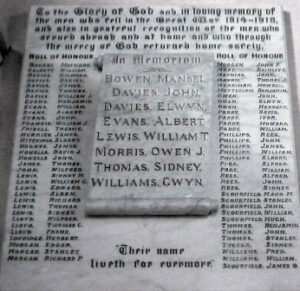
Mansel Bowen, Private, 307166, Lancashire Fusiliers. Mansel was the son of Richard and Mary Bowen, of Big House, Cold Blow. He had worked as a Railway Plate Layer for several years prior to the war, and had lived with his uncle Richard Davies at Tredworth, 19 Penybank Road, Ammanford. Mansel enlisted at Narberth into the army and was posted to the 2/8th Battalion, Lancashire Fusiliers, which was attached to the 197th Brigade, 66th Division. The Division landed at Le Havre on 28 February 1917 and moved to the Flanders Coast. At the end of September it was moved south to reinforce the Allied troops assaulting the Passchendaele Ridge, during the Third Battle of Ypres. On 5 October the division relieved the 3rd Australian Division in the front line near Poelcappelle. The division attacked from their trenches following a heavy artillery bombardment on the morning of 9 October 1917, but found the German defences untouched by the artillery barrage. After heavy fighting elements of the division forces their way into Passchendaele village, but were later forced to retire. Mansel was killed in action during this fighting around the village on 9 October 1917 aged 37. His body was lost on the battlefields, and so he is remembered on the Tyne Cot Memorial, Belgium. Many thanks to Keith Bowen for the photograph of Mansel.
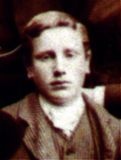
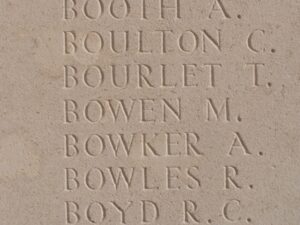
George Elwyn Davies, Private, 282284, Lancashire Fusiliers. George was the son of William and Elizabeth Davies, of Brynmor, Templeton. He had worked as a Butcher at Narberth prior to the war and enlisted at Narberth into the Pembroke Yeomanry. After completing his training George was posted to the 2/7th Battalion Lancashire Fusiliers, which was attached to 197 Brigade, 66th Division. The Battalion landed at Havre on 28 February 1917, moving to the Belgian coast, where a secret offensive, Operation Hush, had been planned. At the end of September it was moved south to reinforce the Allied troops assaulting the Passchendaele Ridge, during the Third Battle of Ypres. On 5 October the division relieved the 3rd Australian Division in the front line near Poelcappelle. The division attacked from their trenches following a heavy artillery bombardment on the morning of 9 October 1917, but found the German defences untouched by the artillery barrage. After heavy fighting elements of the division forces their way into Passchendaele village, but were later forced to retire. George was badly wounded at Passchendaele and brought back to the Casualty Clearing Station at Remy Sidings, where he sadly died of Wounds on 11 November 1917, aged just 22. He is buried there at Lijssenthoek Military Cemetery, Belgium. The photo of George is courtesy of Narberth Museum.
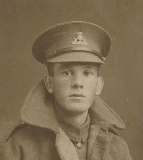
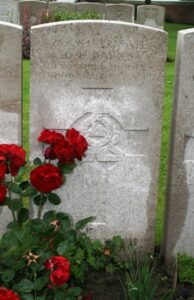
John Davies, Private, 54297, Royal Welsh Fusiliers. John was born at Templeton, and was called up for military service in 1916, joining a training battalion of the Welsh Regiment. He was then posted to the 9th Battalion, Royal Welsh Fusiliers, which was in France attached to 58 Brigade, 19th (Western) Division. The Division had been in France since July 1915, and had fought at the Battle of Loos and on the Somme before John joined their ranks. By the summer of 1917 it had moved to positions south of Ypres, at Messines, where it took part in the great Battle of Messines, which was launched by the blowing of nineteen huge underground mines on 7 June 1917. John was killed that same day, during the initial attack of the 19th Division towards the Red Line near Oostaverne. He is buried at Wytschaete Military Cemetery, Belgium, in Grave Ref. IV. C. 14.
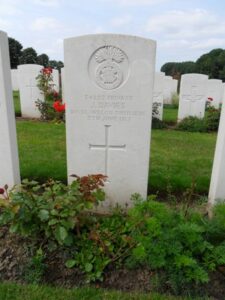
Benjamin Albert Evans, Private, 307167, Lancashire Fusiliers. Benjamin was born at Templeton in 1892, the son of Price and Elizabeth Evans. The family later resided at 40, Mackworth Street, Bridgend, Glamorgan. Benjamin had initially served with the 2/8th Battalion, Lancashire Fusiliers, which was attached to 197 Brigade, 66th (2nd East Lancs) Division, but does not appear to have served overseas with the battalion. At some time Benjamin had been medically downgraded, and was posted to the 533rd Agricultural Company, Labour Corps, with his service number changing to 67103. Benjamin died as on 7 February 1919, aged 26. He is buried at Molleston Baptist Chapelyard, Templeton.
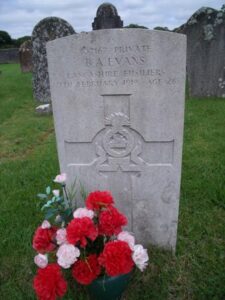
William Thomas Herbert Lewis, Private, 48989, Royal Army Medical Corps. William was the son of Ann Lewis, of Park Villa, Templeton. He enlisted at Haverfordwest into the Army, and was posted to the 13th Field Ambulance, Royal Army Medical Corps. The 13th F.A. was attached to the 5th Division, which had been in France since 15 August 1914, and had fought at the Battle of Mons, and during the retreat south, fighting at Le Cateau, then down to the Marne where the German attack was halted. They took part in the advance to the Aisne, before moving to Flanders, where they fought at the Battle of La Bassée, then at Messines in October, 1914. They fought here through First Ypres, and took part in the capture of Hill 60, and then fought at Second Ypres in April 1915. March 1916 saw the Division moving to positions between St. Laurent-Blangy and Vimy, near Arras, and the Division saw plenty of action during its spell here. On 1 July 1916 the Battle of the Somme opened, and the Division moved south fighting at High Wood, Guillemont, Flers-Courcelette, Morval and Le Transloy. William was killed during the later stage of the Somme offensive, on 3 September 1916, aged 23, whilst attempting to rescue a wounded soldier while under shell fire. He is buried at Hamel Military Cemetery, Beaumont Hamel, France, in Grave Ref. I. F. 29.
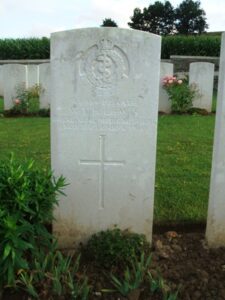
Owen James Morris, Private, 325683, Queen’s Own Worcestershire Hussars (Worcester Yeomanry). Owen was the son of Joseph and Ann Morris, of Mounton, Templeton. He lived at 14, St. Martin Street, Birmingham prior to the outbreak of war, working as a Coach Painter, and enlisted there into the Worcester Yeomanry. The unit formed for war on 4 August 1914, as part of the 1st South Midland Mounted Brigade. On 11 April 1915 they sailed from Avonmouth, arriving at Alexandria on 22 April 1915, before moving to Suvla Bay, Gallipoli. During November 1915 the 1/1st Worcester Yeomanry returned to Egypt, where the 2nd Mounted Division which it was attached to was broken up and the brigade became the 5th Mounted Brigade. In February 1917 the brigade moved to the Imperial Mounted Division, and took pat in the advance into Palestine. Owen became ill during the offensive, and died on 14 May 1917, aged 32. He is buried at Deir El Belah War Cemetery, Israel, in Grave Ref. C. 69. The photograph of Owen is courtesy of Louisa Billington.
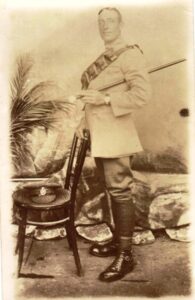
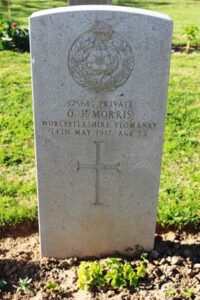
Sidney Vaughan Thomas, Private, 48409, South Wales Borderers. Sidney was born at Ludchurch on 23 January 1899, the son of Margaret Thomas. The family later resided at 5, Wells Road Terrace, Narberth. Sidney worked as a Goods Clerk for the Great Western Railway at Pontlliw prior to the war and enlisted at Swansea into the army. He was posted to the 6th Battalion, South Wales Borderers, which was the Pioneer battalion to the 25th Division. The Division had fought at the Battles of Arras, Messines and Passchendaele in 1917. November saw them move south again, where they took part in the Battle of Cambrai. They remained in the area over the final winter of the war, and were stationed near Gouzeaucourt when the Germans launched their Spring Offensive. Sidney was killed by a shell during the first morning of the offensive, on 21 March 1918. He was just 19 years old, and is commemorated on Bay 6 of the Arras Memorial, France.
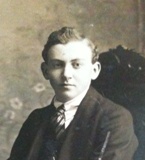
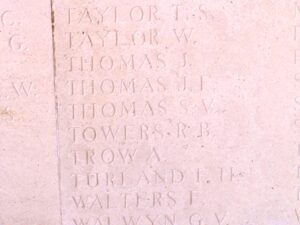
Gwyn Williams, Private, 21110, Royal Dublin Fusiliers. Gwyn was born at St. Clears, and had been brought up by James and Mary John, at Tynewydd, St. Clears. He had lived at Templeton prior to the war and married Jessie Miriam Scourfield of Templeton in 1915. He enlisted at Cardiff into the Army, and was posted to the 2nd Battalion, Royal Dublin Fusiliers, which was attached to 48 Brigade, 16th (Irish) Division. During December, 1915 the Division moved to France and concentrated in the Bethune area. They saw their first major action during the Somme Offensive, at the Battle of Guillemont, and also fought at the Battle of Ginchy. By May, 1917 the Division had moved to positions south of Ypres, where they fought at the Battle of Messines, and then moved north, fighting at the Battle of Langemarck, before returning to Arras. Gwyn was killed in action at Arras on 7 October 1917. He has no known grave, and is commemorated on the Arras Memorial, France, on Bay 9.
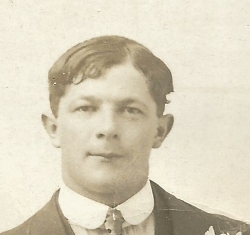
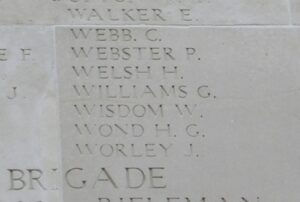
World War Two, 1939-1945
William Alfred Cyril Davies, Pilot Officer (Air Gunner), 179238, Royal Air Force Volunteer Reserve. David was the son of David Howard Davies and Minnie Davies (nee Morgan), of Templeton. He served with 630 Squadron, RAF, which was a heavy bomber squadron, equipped with the Avro Lancaster, based at East Kirkby, Lincolnshire. William was probably killed while his Lancaster was returning from a mission to bomb a synthetic oil plant in Germany on the night of 21/22 August 1944. He was 23 years old, and is buried at Templeton (St. John) Churchyard.
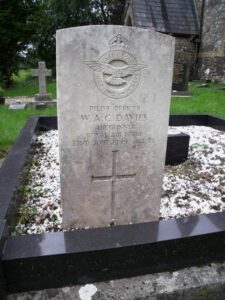
Ernest Ivor Hughes, Serjeant, 915869, Royal Artillery. Ernest was the son of John Hughes and Sarah Rebecca Hughes (nee Killa), of Templeton. He served with 102 (The Pembroke Yeomanry) Field Regiment, Royal Artillery, which landed at Algiers in February 1943 as part of the 1st Army. After the fall of Tunis they converted to a medium artillery regiment and landed in Italy with the 8th Army, in December 1943. Ernest was killed soon after, on 22 January 1944. He was 25 years old, and is buried at Minturno War Cemetery, Italy, in Grave Ref. II, F, 13.
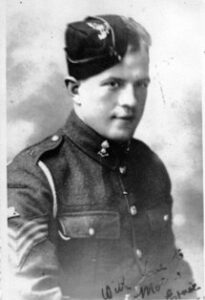
Desmond Charles James Calcutt John, Guardsman, 2735127, Welsh Guards. Desmond was the son of Harry and Veneda Rachiel John (nee Calcutt), of Templeton. He was educated at Tenby, and was a regular soldier, serving with the 1st Battalion, Welsh Guards at the outbreak of war. The Welsh Guards moved to France as part of the BEF, and took up positions in the city of Arras on 17 May 1940. In May 1940, the Germans launched their Blitzkrieg into France, and Arras was bombed heavily on 19 May, with heavy fighting following. On 24 May the Welsh Guards were ordered to withdraw, and began a fighting retreat towards Dunkirk. Desmond was killed during a brief, but fierce, rearguard action at West Cappel on 29 May 1940. The German advance was delayed, but at a heavy cost to the Welsh Guards. Desmond was 20 years old, and is buried at West Cappel Churchyard, Belgium. He is also commemorated on the Tenby War Memorial.
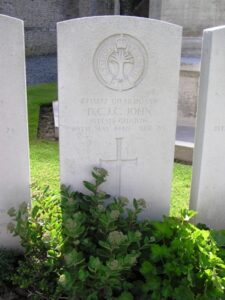
Oliver Maurice Lewis, Serjeant, 3959510, Pioneer Corps. Oliver was the son of John Thomas Lewis and Lilian Lewis (nee Morgan), of Templeton. He served with the Pioneer Corps. Little else is known, but Oliver died on 5 January 1943, aged 29, and is buried at Templeton Congregational Chapel Cemetery.
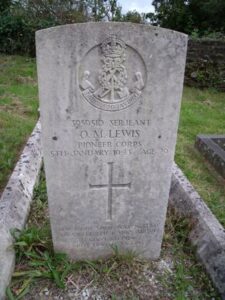
James Edgar John Mason, Stoker I, C/KX 143988, Royal Navy. James was born on 3 September 1920, the son of William and Catherine Mary Mason, of Haorstone, Martletwy. He married Winifred Mabel Eileen Allen, of Ruelwall, Llanteg in 1942. He served in the Royal Navy as a stoker aboard the Royal Naval Vessel, H.M.L.B.O.6. The vessel was in fact a device that had been invented purely for the Normandy Landings, and was a Landing Barge, Oil. These Landing Barges came in a huge variety of different types, and were used for several purposes; defence, transportation, supply (of food, water and oil) and repair (fitted out with workshops). Little is known of what happened, but John is recorded as having been killed on 14 June, 1944 aged just 23. He is remembered on the Chatham Naval Memorial, Kent.
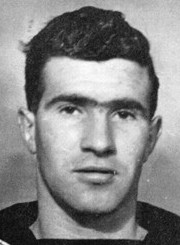
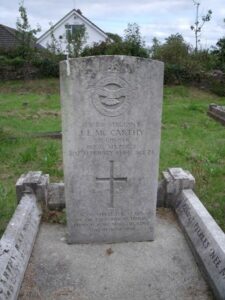
John Emmanuel McCarthy, Sergeant (Air Gunner), 1836186, Royal Air Force Volunteer Reserve. John was the son of Patrick and Mary McCarthy. He married Gladys Elizabeth Morgan, of Templeton in 1942 while based in Pembrokeshire with the Royal Air Force. He served with 460 (Royal Australian Air Force) Squadron, RAF, which was a heavy bomber squadron, equipped with the Avro Lancaster, which flew from RAF Breighton. John served as Air Gunner on the crew of Flight Sergeant G. A. Grant, and on the night of 20 February 1944, the crew of eight flew as part of a massive raid on Stuttgart. On their return the following morning of 21 February 1944, the Lancaster crashed with the loss of all eight of her crew. John was 24 years old, and was brought home for burial at Templeton Congregational Chapel Cemetery. He had flown fifteen combat missions by the time of his death.

Thomas Melgwyn Neale, Fusilier, 4208890, Royal Welch Fusiliers. Thomas was the son of Edwin Neale and Mary Neale (nee Roose), of Redberth. He married Annie Mary Elizabeth Mason of Templeton in 1941. He served with the 6th Battalion, Royal Welch Fusiliers, which was part of the 53rd (Welsh) Division that landed on Normandy at the end of June, 1944. Thomas was killed during the fighting in the Bocage on 17 July 1944. He was 24 years old, and is commemorated on the Bayeux Memorial, France. Thomas is also commemorated on the Carew War Memorial.
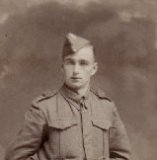
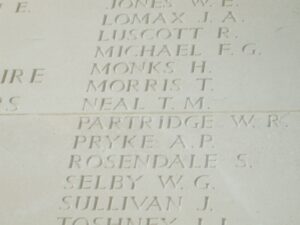
Richard Benjamin Thomas, Marine, PO/X 108788, Royal Marines. Richard was born in Templeton in 1922. He served with the Royal Marines, and after the Normandy Landings of 6 June 1944, was serving with 27th Battalion, Royal Marines. The battalion took part in the drive through Holland in 1944, and then into Germany, where Richard was killed, just six days before the surrender of Germany, on 29 April 1945. He is buried at Becklingen War Cemetery, Germany, in Grave Ref. 7. G. 11.